Vatican
About Andrew Cusack
 Writer, web designer, etc.; born in New York; educated in Argentina, Scotland, and South Africa; now based in London.
Writer, web designer, etc.; born in New York; educated in Argentina, Scotland, and South Africa; now based in London. read more
News
Blogs
Reviews & Periodicals
Arts & Design
World
France
Mitteleuropa
Knickerbockers
Argentina
The Levant
Africa
Cape of Good Hope
Netherlands
Scandinavia
Québec
India
Muscovy
Germany
Academica
Special Mission to Rome
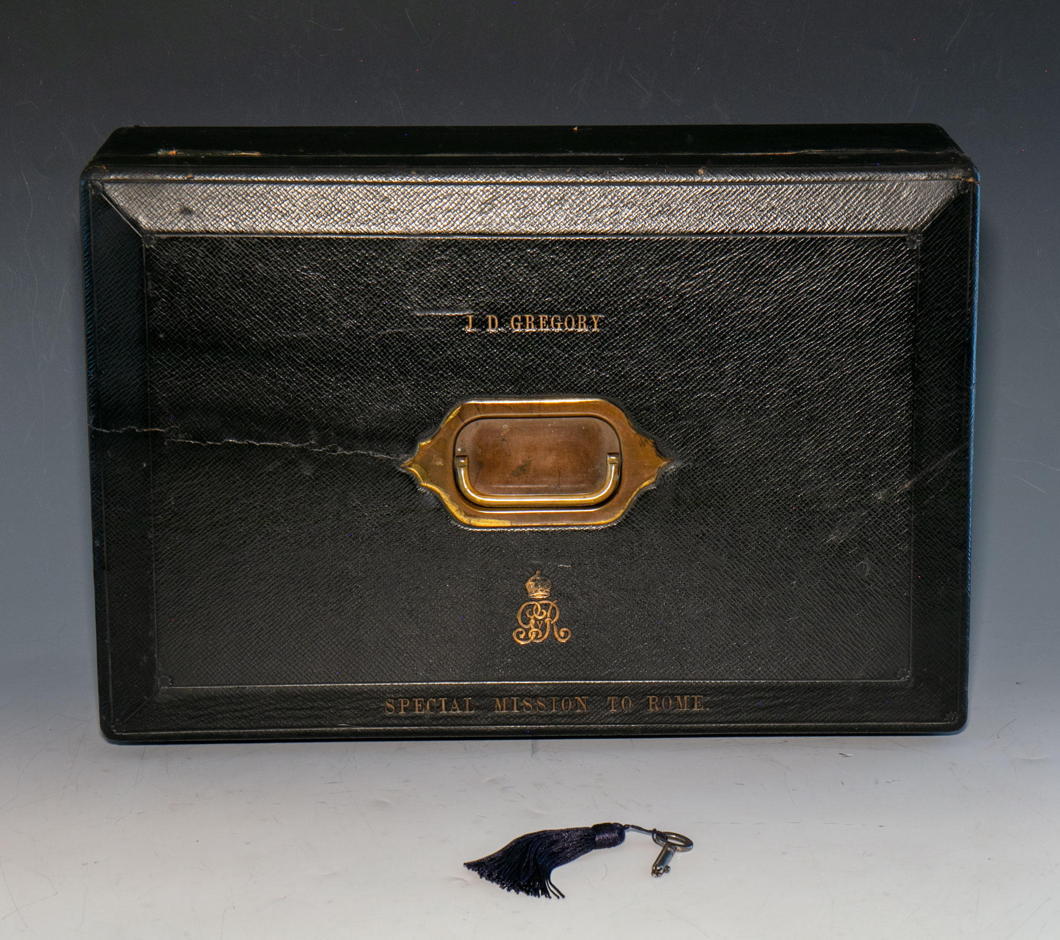
RELATIONS BETWEEN THE Court of St James’s and the Holy See have evolved in the many centuries since the Henrician usurpation. At times, such as during the Napoleonic unpleasantness, the interests of London and the Vatican were very closely aligned — despite the lack of full formal diplomatic relations. Later in the nineteenth century Lord Odo Russell was assigned to the British legation in Florence but resided at Rome as an unofficial envoy to the Pope.
It wasn’t until 1914 that the United Kingdom sent a formal mission to the Vatican, but this was a unique and un-reciprocated diplomatic endeavour — a full exchange of ambassadors would have to wait until 1982. (Until then, the Pope was represented in London only by an apostolic delegate to the country’s Catholic hierarchy rather than any representative to the Crown and its Government.)
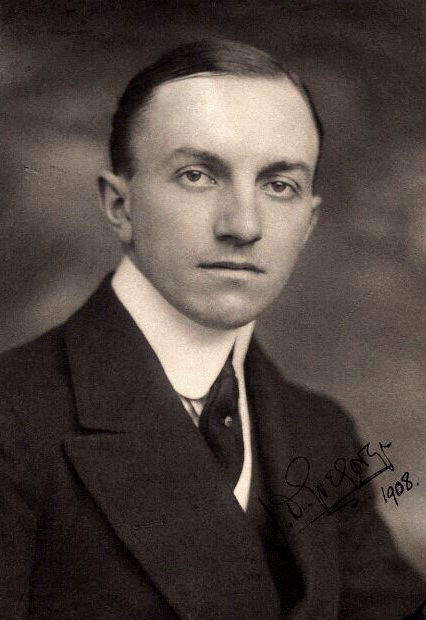 Within a year of the Special Mission to Rome being established, John Duncan Gregory (later appointed CB and CMG) was assigned to it. A diplomat since 1902 who had previously worked in Vienna and Bucharest, he was one of the central figures in the curious ‘Francs Affair’ of 1928, when two British diplomats were believed to have unduly abused their positions to speculate in currency. Despite being cleared of illegality, J.D. Gregory was dismissed from his diplomatic posting — though he was later rehabilitated.
Within a year of the Special Mission to Rome being established, John Duncan Gregory (later appointed CB and CMG) was assigned to it. A diplomat since 1902 who had previously worked in Vienna and Bucharest, he was one of the central figures in the curious ‘Francs Affair’ of 1928, when two British diplomats were believed to have unduly abused their positions to speculate in currency. Despite being cleared of illegality, J.D. Gregory was dismissed from his diplomatic posting — though he was later rehabilitated.
If there are any enthusiasts of the curious subcategory of accoutrement known as the despatch box, J.D. Gregory’s one dating from his time in Rome is currently up for sale from the antiques dealer Gerald Mathias.
It was manufactured by John Peck & Son of Nelson Square, Blackfriars, Southwark — not very far at all from me as it happens. (more…)
Romes that Never Were
When the splendidly named Saint Sturm – Sturmi to his friends, apparently – founded the Benedictine monastery of Fulda in A.D. 742 we can presume he had no idea that the magnificent church eventually erected there (above) would one day be considered for housing the Supreme Pontiff of the Universal Church.
Rome, caput mundi, is ubiquitously acknowledged by all Christian folk as the divinely ordained location for the Papacy, but this has not always been acknowledged in practice. Most memorable is the “Babylonian Captivity” of the fourteenth century when the papal court was based at the enclave of Avignon surrounded by the Kingdom of Arles. The illustrious St Catherine of Siena was influential in bringing that to an end.
Since the return from Avignon the Successor of Peter has prudently been keen to stay in Rome, but various crises over the past two centuries have seen His Holiness shifted about. General Buonaparte successively imprisoned Pius VI and Pius VII while he made to refashion Europe in his likeness, and the later slow-boil conquest of the Italian peninsula by the Kingdom of Sardinia caused much worrying in the courts of the continents as well.
In 1870, the Eternal City fell to the troops of General Cadorna, and while the Vatican itself was not violated it was widely assumed the papacy could not stay in Rome. Pope Pius IX evaluated several options, one of them seeking refuge from – of all people – the Prussian king and soon-to-be German emperor Wilhelm I.
Bismarck, no ally of the Church, but shrewd as ever, was in favour of it:
I have no objection to it — Cologne or Fulda. It would be passing strange, but after all not so inexplicable, and it would be very useful to us to be recognised by Catholics as what we really are, that is to say, the sole power now existing that is capable of protecting the head of their Church. …
But the King [Wilhelm I] will not consent. He is terribly afraid. He thinks all Prussia would be perverted and he himself would be obliged to become a Catholic. I told him, however, that if the Pope begged for asylum he could not refuse it. He would have to grant it as ruler of ten million Catholic subjects who would desire to see the head of their Church protected. …
Rumours have already been circulated on various occasions to the effect that the Pope intends to leave Rome. According to the latest of these the Council, which was adjourned in the summer, will be reopened at another place, some persons mentioning Malta and others Trent.
Bismarck mused to Moritz Busch what a comedy it would be to see the Pope and Cardinals migrate to Fulda, but also reported the King did not share his sense of humour on the subject. The advantages to Prussia were plain: the ultramontanes within their territories and throughout the German states would be tamed and their own (Catholic) Centre party would have to come on to the government’s side.
In the end, of course, the Pope decided to stay put in Rome and became the “Prisoner of the Vatican”, surrounded by an awkward usurper state that made attempts at friendship without betraying its hopes for legitimising its theft of the Papal States. It was the diplomatic coup of the Lateran Treaty in 1929 that finally allowed both states to breathe easy and created the State of the City of the Vatican, an entity distinct from but subservient to the Holy See of Rome.
The Second World War brought its own threats to the Pope’s sovereignty, and the wise and cautious Pius XII feared he might be imprisoned by Hitler just as his predecessor and namesake had been by Buonaparte. Pius was determined the Germans would not get their hands on the Pope and so signed an instrument of abdication effective the moment the Germans took him captive. He would have burnt his white clothing to emphasise that he was no longer the Bishop of Rome.
The record is not yet firmly established but it is rumoured that the College of Cardinals was to be convened in neutral Éire to elect a successor. One wonders where they would have met. The Irish government would undoubtedly have put something at their disposal — Dublin Castle perhaps? Despite the whirlwind of war, the election of a pope in St Patrick’s Hall would have warmed the cockles of many Irish hearts.
But what then? Ireland’s neutrality would have been useful but a German violation of the Vatican’s territory would have been grounds for open, though obviously not military, conflict. Further rumours, also totally unsubstantiated, had it that the King of Canada, George VI, quietly had plans drawn up for offering the Citadelle of Quebec to the Pope to function as a Vatican-in-Exile. Others claim it wasn’t until the 1950s that Quebec was investigated as a possibility by the Vatican in case Italy went communist, as was conceivable.
So Cologne, Fulda, Malta, Trent? None of these plans ever occurred, thank God.
And what about England? Why not? The court of St James and the Holy See, despite obvious and significant differences, enjoyed close relations and overlapping interests in many particular circumstances from the Napoleonic wars until present. Pius IX had put feelers out to Queen Victoria’s minister in Rome, Lord Odo Russell, in 1870 but the British ambassador more or less told him of course the Pope would be welcomed in England but don’t be silly, the Sardinians would never conquer Rome.
One imagines the British sovereign would grant a palace of sufficient grandeur to the exiled Pontiff. Hampton Court would do the job. It’s far enough from the centre of London but large enough to house a small court and the emergency-time administration of the Holy Roman Church. Would the ghost of Cardinal Wolsey plague the Princes of the Church?
Thanks be to God, we’ve never had cause to find out. At Rome sits the See Peter founded and so it looks to remain. Ubi Petrus, ibi ecclesia.
The L.A. Times on Papa Pacelli
How News of the Election of Pius XII was Received in 1939
The case against Pope Pius XII, accusing him of complicity in the crimes of Nazism, has been so thoroughly debunked — by Jews like Gary Krupp and Rabbi Dalin more than any — that it is no longer even worth refuting.
Still, it’s interesting to read the Los Angeles Times’s coverage of his election as Supreme Pontiff in the difficult year of 1939:
BLOW TO NAZIS
… The choice of Cardinal Pacelli is believed certain to provoke annoyance in Germany, where he long has been regarded as a moving spirit behind the Vatican’s opposition to Nazi policies.
As the news report goes on to note, Cardinal Pacelli was elected in only three ballots — the quickest papal election since that of Leo XIII in 1878.
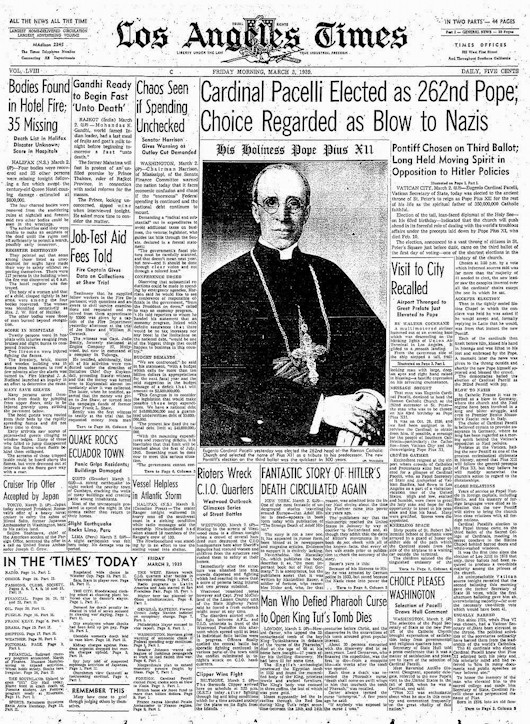
The Spina di Borgo
The Baroque is a style of joy. It is often hailed (or derided) as the most Catholic of styles and in some sense this is true. The festivity and physicality of the Baroque reflect the God that Catholics worship — “the Love that moves the Sun and other stars” as Dante put it — but a Love made incarnate, made man, in a very real and tangible world.
The Baroque is also the style of the surprise: the corner turned to an unexpected vista or the jet of water sprinkling a king’s unsuspecting courtier.
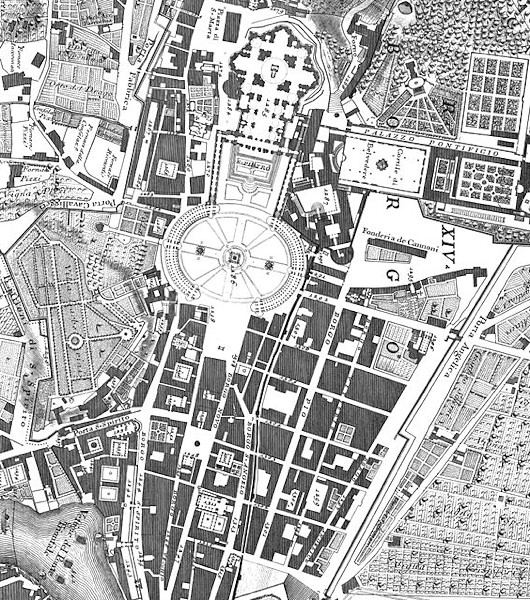
One of the most superb examples of this was the great basilica church of Saint Peter in Rome where prince, pilgrim, and pauper alike moved in a dark warren of palaces, hovels, churches, and alleyways, perhaps catching an occasional glimpse of the great dome looming as they closed in on San Pietro, finally to emerge from the shadow into the great light of the piazza.
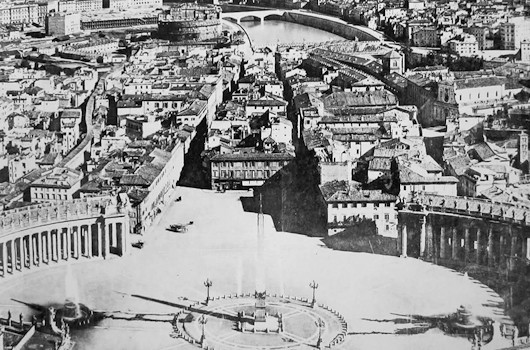
That warren of buildings was the Spina di Borgo (“Spine of the Borgo”) but this experience is now sadly lost to us since the 1930s when the Kingdom of Italy’s fascist premier Benito Mussolini decided to raze the neighbourhood. Instead we now have the long boulevard called the Via della Conciliazione, named in commemoration of the Lateran Treaty establishing formal relations between the Holy See and the Italian state.
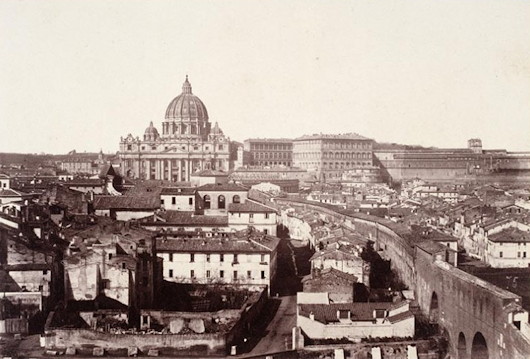
While Il Duce ostentatiously took credit for this urban crime by symbolically swinging the pickaxe beginning demolition, the concept, though flawed, was in fact an old one. Leon Battista Alberti submitted proposals during the reign of Pope Nicholas V (mid fifteenth century), and numerous other architects — Carlo Fontana, Giovanni Battista Nolli, Cosimo Morelli — drew up similar plans. The Piazza San Pietro only took its now instantly recognisable form in the 1650s when the curved flanking collonades enclosed the space like great welcoming arms superbly framing the basilica’s façade.
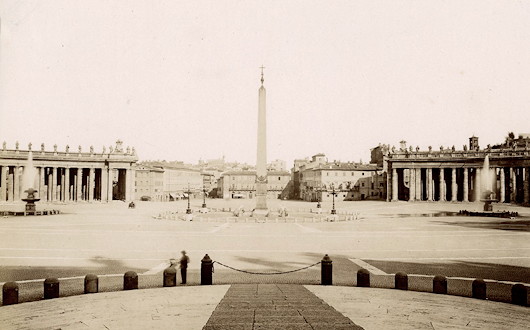
Mussolini turned to Marcello Piacentini — an accomplished if sometimes uneven architect — assisted by Attilio Spaccarelli. Piacentini favoured closing off the view from the avenue with a closed collonade, echoing Bernini’s own plans for the piazza, but was overruled.
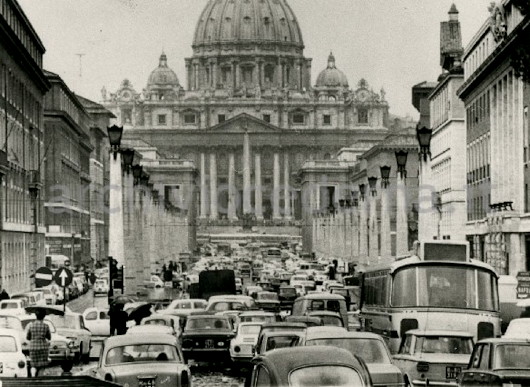
The razing of the Spina presented a problem in that the undemolished buildings left flanking the Via della Conciliazione were now mostly at odd angles to the new boulevard. Piacentini attempted to solve this by flanking the road with two rows of obelisks that doubled as streetlamps providing a line directing the viewer towards the great basilica beyond, otherwise unimpeded by any visual interruption.
Overall the construction of the Via leaves a rather boring and clinical feeling. The charm and chaos of the Spina has been replaced by a clean and dull boulevard, useful for little more than traffic efficiency and crowd control. The loss of the Spina di Borgo is mourned.
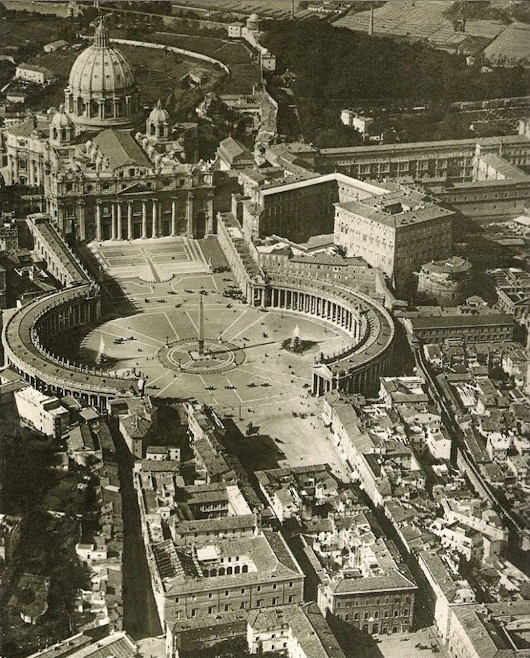
No ‘Malvinas’ Here
Some difficulties of Latin place names in 1930s cartography
It’s no great secret I’m a lover of maps. When calling in to the Secretariat of State on the terza loggia of the Apostolic Palace in the Vatican the other day, I was very pleased to see the cartographic murals there, including the two hemispheres done by Ignazio Danti in the 1580s. Moving to the next interior offices, however, the visitor is greeted by a much more recent mappa mundi, dating from the 1930s, replete with the glamour of empire’s heydey. (more…)
L’Osservatore Romano goes Hungarian
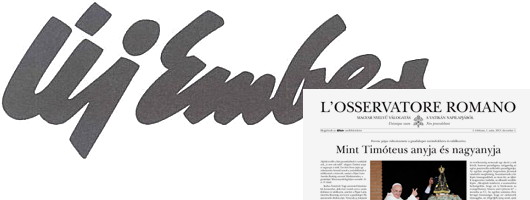
Magyarophiles will be pleased to learn that L’Osservatore Romano, the Vatican newspaper, will begin appearing in Hungarian. The new edition will appear every other week as a four-page insert into Új Ember, the Hungarian Catholic weekly founded in 1945. “We are a small editorial staff,” Balázs Rátkai, editor-in-chief of the weekly, told L’Osservatore.
“However, our intention is to probe and to make our readers think. The collaboration with the Vatican daily is of historic importance for the life of the weekly and of the entire local Church; it not only brings the Universal Church and the Pope closer to us; it will also enrich readers, and through them all of Hungarian society, with new thoughts, opinions and answers.”
Printed as a daily broadsheet in Italian, the Vatican newspaper also has weekly tabloid editions in French, Spanish, English, German, and Portuguese, as well as a monthly version in Polish.
Better late than never
Old hat already, but following the announcement of Benedict XVI’s abdication, the Los Angeles Times solicited opinions from eleven American Catholics — among them your humble & obedient scribe — what they would like to see in the new pope.
I posted in on Twitter, but in case you didn’t catch it there, you can find my contributions (in addition to those of the ten others) at this link. (more…)
Against the Dictatorship of Relativism
Pope Francis continues Benedict XVI’s fight
… But there is another form of poverty! It is the spiritual poverty of our time, which afflicts the so-called richer countries particularly seriously. It is what my much-loved predecessor, Benedict XVI, called the “dictatorship of relativism”, which makes everyone his own criterion and endangers the coexistence of peoples. And that brings me to a second reason for my name. Francis of Assisi tells us we should work to build peace. But there is no true peace without truth! There cannot be true peace if everyone is his own criterion, if everyone can always claim exclusively his own rights, without at the same time caring for the good of others, of everyone, on the basis of the nature that unites every human being on this earth.
“For those tempted to draw an overly sharp distinction between Pope Francis and his predecessor,” John Allen reports, “the new pope offered a clear reminder Friday that he may have a different style than Benedict XVI, but on substance, he’s cut from much the same cloth.”
“In a speech to the diplomatic corps accredited to the Holy See on Friday, Francis lamented not only the material poverty of the early 21st century but also its ‘spiritual poverty,’ meaning a rejection of God and objective standards of morality.”
Also, I found it interesting that the Holy Father noted that his background in an Argentine family of Italian origin impelled him in his role as bridge-builder. Naturally, as someone from an Estadounidense family of Irish origin, I feel a certain parallel kinship to this first American pope.
[Note: The boldface below is mine.] (more…)
Pope Francis
THE SACRED COLLEGE have elected Jorge Mario Bergoglio, Cardinal Archbishop of Buenos Aires, to be Rome’s new bishop and our Supreme Pontiff. He has chosen to take the name of FRANCIS.
One immediately recalls the words Our Lord spoke to Francis of Assisi in the great saint’s vision at San Damiano:
We pray that the Holy Father will continue the work of his predecessors in safeguarding the flock, and will do his part to fulfil the task given to his namesake, St Francis of Assisi.
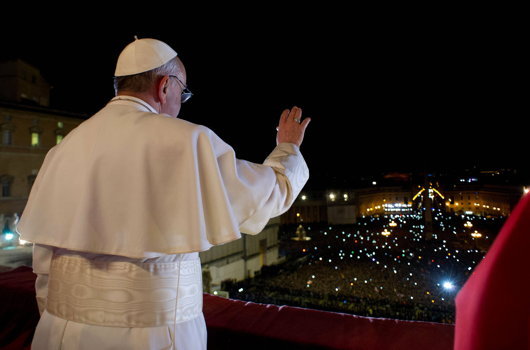
Vatican Insider
Anyone remotely interested in the important affairs of the church and the world should make themselves aware of the new ecclesial news site, Vatican Insider. The site offers English translations of the significant journalistic output of the Italian newspaper La Stampa and includes commentary from Andrea Tornielli, John Allen, and others. V.I. already has an interview with Mons Georg Ratzinger and a look at church-state relations in mainland China, amongst other things. Definitely one to add to your daily perusing.
Media Lies About the Pope
In an interview, Benedict XVI reaffirmed the immorality of using condoms, but the press have spread a lie claiming he did the exact opposite
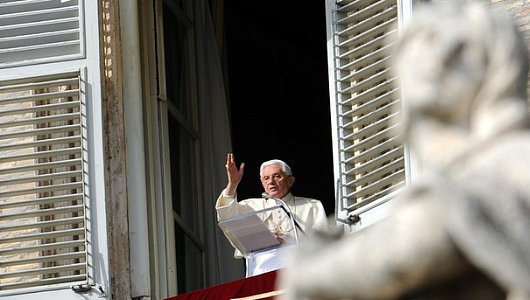
Wow. Just wow. No matter how low my opinion of journalists and the media already is, they’ve proved that they still have the ability to astound by the depths of their depraved mendacity. The latest big giant whopper the media are dealing out is that Pope Benedict XVI has ‘changed church teaching’ by ‘lifting the absolute ban on condom use’. You should know by now that when the media report almost anything relating to the Pope or the Church, the reality is either A) the media have completely made it up, or B) the exact opposite of what the media say is true.
This one we can file under “B”: the Pope has reaffirmed the immorality of using condoms and the media have decided to claim the opposite. A new book, Light of the World is being published this week containing several interviews with the Pope by the German journalist and editor Peter Seewald.
When asked about the Church’s teaching on condoms, the Pope reaffirmed that the Church “of course does not regard it as a real or moral solution”. However, the Holy Father speculated about the intent of some condom users. (more…)
Rod Dreher is Profoundly Mistaken
Rod Dreher, a normally interesting commentator and incisive thinker, is profoundly mistaken in his response to the Pope’s handling of the Schönborn-Sodano spat, and betrays a fundamental misunderstanding of what’s gone on.
In April, Cardinal Schönborn, the Archbishop of Vienna, publicly and by name criticised Cardinal Sodano, the former Vatican Secretary of State, accusing him of having frustrated attempts to investigate abuse by clerics and further criticising his dismissal of some claims of abuse as “petty gossip”. These criticisms were largely seen as justified in their substance but were note-worthy as it is not customary for cardinals to attack one another publicly and by name.
The Pope then oversaw a meeting between Cardinal Schönborn and Cardinal Sodano (who, since 2006, is no longer Secretary of State) as an act of reconciliation. Alongside this meeting, a statement was released which included a gentle reminder that authority over the College of Cardinals is reserved to the Holy Father, and that likewise the supervision and criticism of cardinals is reserved to him, in consultation with others.
The reservation of this right to the Pope is both wise and justified. The basic idea is that cardinals are not to waste their time criticising one another, lest they, being human, be tempted into continual criticism which would interfere with and impede the work of their fellow cardinals.
The gentle reminder in this statement has, unfortunately, been blown completely out of proportion by the media. Rod Dreher has only augmented this with his commentary, but in doing so betrays a fundamental error that he made: his comments cite an Associated Press report of the supposed “unprecedented public rebuke”.
It is no surprise that Dreher found the AP report “both heartbreaking and infuriating”, as that is generally what AP reports related to the Church are designed to do. The Associated Press has fairly consistently and over a long period of time demonstrated their lack of reliability or journalistic credibility owing to their complete lack of understanding of how the Church operates and their undercurrent of antagonism to Christianity in general.
It is more “heartbreaking and infuriating” that a man as smart as Rod Dreher has had such a lapse of judgement as to allow the Associated Press to be the informer of his thoughts and guide of his heart. Dreher’s claim that Pope Benedict has “humiliated” Schönborn is complete nonsense, which is the result of Dreher’s unfortunate trust in the sham journalism of wire services. Dreher is also simplistic in his treatment of Cardinal Schönborn, who has been known to have gone a bit loopy of late, even to the extent of expressing reserved support for the ridiculous “apparitions” at Medjugorje, and even suggesting the Pope might visit the town some day.
The Archbishop of Vienna’s stringent stand against clerical abuse is nonetheless a most welcome counterpoint to the lackadaisical approach of the John Paul II-era curia. Small wonder the Pope spent the beginning of his pontificate making very wise replacements of questionable JP2 appointments, and continues to have a good eye for decent churchmen and for appropriate roles for them to exercise in the Vatican.
“This action by the pope is not a sign of strength,” writes Dreher, “but its opposite.” Does Dreher really think that allowing a cardinalatial free-for-all would be a sign of strength, while taking steps to remind cardinals of their obligations is a sign of weakness? Rather, Benedict has, as has been the mark of his pontificate, taken the route of gentleness and reconciliation while simultaneously stressing the need for order and unity.
Recent Promulgations from the Holy See
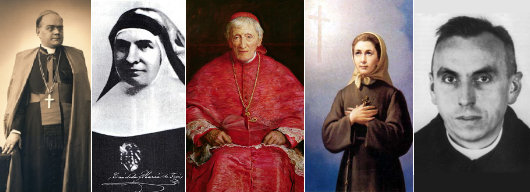
Decrees recently promulgated in the Vatican move sixteen candidates for sainthood forward in their cause. The most famous of the twelve is the English cardinal & convert from Anglicanism, John Henry Newman (above, center). A miracle attributed to the intercession of Cardinal Newman has been accepted by the Congregation for the Causes of the Saints. The Congregation has also accepted individual miracles attributed to the intercession of: Blessed Cándida Maria de Jesús Cipitria y Barriola (above, second from left; 1845-1912), the Spanish founder of the Congregation of the Daughters of Jesus; the Servant of God Angelo Paoli (below, second from right; 1642-1720), an Italian Carmelite priest; the Servant of God Maria Alfonsina Danil Ghattas (1843-1927), a cofounder of the Congregation of the Sisters of the Most Holy Rosary of Jerusalem.
Eight martyrs were proclaimed in the recently-promulgated decrees: all of them of the twentieth century and all of them victims of totalitarianism. Fr. Teófilo Fernández de Legaria Goñi (below, far left) and four companions (all professed priests of the Congregation of the Sacred Hearts of Jesus and Mary), as well as the diocesan priest Fr. José Samsó i Elías (below, far right), were all killed by the Communists in 1936 during the horrible persecution of the Church during the Spanish Civil War. Fr. Georg Häfner (above, far right), a German diocesan priest, was killed in the concentration camp of Dachau in 1942 under the Nazi regime. Bishop Zoltán Lajos Meszlényi (above, far left), an auxiliary bishop of Esztergom, was killed at Kistarcsa in Hungary by the Communist authorities in January 1953.
Proclamations of heroic virtue — the first step on the road to being recognised as a saint — were issued for: Fr. Engelmar Unzeitig (below, center; 1911-1945), a German priest of the Mariannhill missionaries; Anna María Janer Anglarill (below, second from left; 1800-1885), the Spanish founder of the Institute of Sisters of the Holy Family of Urgell; Maria Serafina del Sacro Cuore di Gesu Micheli (1849-1911), the Italian founder of the Institute of Sisters of the Angels; Teresa Manganiello (above, second from right; 1849-1876), an Italian laywoman of the Third Order of St. Francis.

A Miracle from Blessed Charles
Vatican to Review Case of Inexplicable Healing of Florida Woman
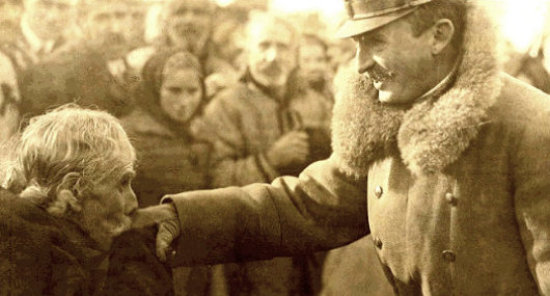
The seemingly inexplicable healing of a Baptist woman from Florida may provide the miracle necessary for the canonization of Emperor Charles of Austria. The woman, in her mid-50s, suffered from breast cancer and was bedridden after the cancer had spread to her liver and bones. Despite treatment and hospitalization, doctors diagnosed her case as terminal. But after intercessory prayers to the Emperor Charles, the woman (who wishes to maintain her privacy and remain unnamed) was completely healed.
The story begins when Joseph and Paula Melançon, a married couple from Baton Rouge, Louisiana and friends of the healed woman, travelled to Austria, where they met Archduke Karl Peter, son of Archduke Rudolf, and grandson of the holy Emperor Charles. The Archduke invited the couple to his grandfather’s beatification in Rome in 2004. Mrs. Melançon gave the novena to Blessed Charles to her sister-in-law, Vanessa Lynn O’Neill of Atlanta.
“I knew that when I got that novena — I knew that my mother’s best friend was sick — I just knew at that moment that it was something I was going to do,” Mrs. O’Neill told the Florida Catholic in an interview. “And that is how I got started, I just prayed the novena.”
The woman’s recovery was investigated by an official church tribunal consisting of Father Fernando Gil (judicial vicar of the Diocese of Orlando), Father Gregory Parkes (chancellor of canonical affairs of the Diocese), Father Larry Lossing, diocesan notary Delma Santiago, as well as an unnamed medical doctor. The tribunal examined the evidence at hand and invited the participation of medical experts, who could find no earthly explanation for the woman’s recovery.
“Other alleged miracles attributed to the intercession of Blessed Karl I are currently being investigated in different places in the world,” Fr. Gil said.
The sixteen-month investigation has now concluded, and the conclusions have been signed by the participants, sealed, and placed in special boxes which are then themselves tied, sealed with wax, and sent to the Congregation for the Causes of the Saints in Rome via diplomatic pouch. The Congregation will examine the case further and then present its findings to Pope Benedict XVI, who will decided if a miracle has taken place. If the Pope is convinced by the evidence, then the Emperor’s canonization can proceed.
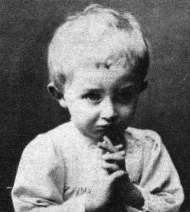 The future emperor, 1889 |
Blessed Charles’s reign as Emperor of Austria and Apostolic King of Hungary began in November 1916 during the First World War. The Emperor realized the heavy toll the Christian countries were suffering and almost immediately began to make peace manouevers. The insane obstinacy of both his German allies and the enemy alliance of France, Great Britain, and the United States, however, meant that Charles’s multiple attempts to negotiate a mutually-acceptable end to the war were not even considered.
After the war, President Woodrow Wilson insisted on dismantling the Austro-Hungarian Empire and the Emperor was forced into exile, first in Switzerland and finally, after two attempts to regain his Hungarian throne, on the Portuguese island of Madeira. Charles had always been particularly devout, and his devotion to God only increased when he caught a severe case of pneumonia on Madeira. He died from the illness in April 1922.
The English writer Herbert Vivian wrote that Charles was “a great leader, a prince of peace, who wanted to save the world from a year of war; a statesman with ideas to save his people from the complicated problems of his empire; a king who loved his people, a fearless man, a noble soul, distinguished, a saint from whose grave blessings come.”
Even Anatole France, the radical French intellectual and novelist, wrote “Emperor Karl is the only decent man to come out of the war in a leadership position, yet he was a saint and no one listened to him. He sincerely wanted peace, and therefore was despised by the whole world. It was a wonderful chance that was lost.”
Recent history has come to fulfil the expectations of Pope St. Pius X, who received Charles when the Austrian was a young archduke and not in direct line to succeed to the throne, saying “I bless Archduke Charles, who will be the future Emperor of Austria and will help lead his countries and peoples to great honor and many blessings–but this will not become obvious until after his death.”
Roma – Caput Mundi
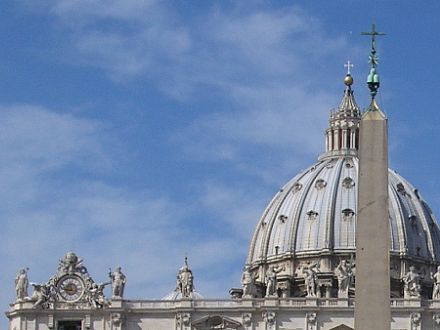
Well I’ve finally got around to putting up my report of our pilgrimage to Rome in March, with a plethora of accompanying photographs. It was an amazing time; Easter excepted, it was the jewel in the crown of our penetential season. Read about it all here.
His Holiness and His Most Eminent Highness
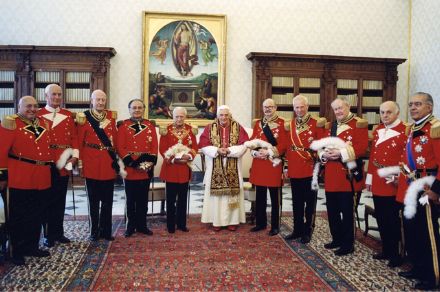
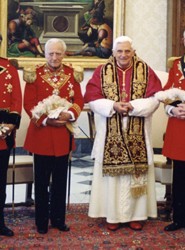 By special request, I bring you photos of the recent audience of His Holiness Benedict XVI, Bishop of Rome, Vicar of Jesus Christ, Successor of the Prince of the Apostles, Supreme Pontiff of the Universal Church, Patriarch of the West, Primate of Italy, Archbishop and Metropolitan of the Roman Province, Sovereign of the State of the Vatican City, Servant of the Servants of God (to use his full title) with His Most Eminent Highness, Fra’ Andrew Willoughby Ninian Bertie, Prince and Grand Master of the Sovereign Military and Hospitaller Order of St. John of Jerusalem, of Rhodes, and of Malta, Most Humble Guardian of the Poor of Jesus Christ (likewise, to use his full title) along with the Sovereign Council of the said order. According to ecclesiastical protocol the Grand Master, though merely a vowed religious, is accorded a dignity equal to that of a cardinal. His Holiness received the Grand Master and Sovereign Council on June 24, 2005, the Feast of St. John the Baptist, who is the patron saint of the Order. The Grand Master was also greeted on April 24 of this year, when the photograph below was taken.
By special request, I bring you photos of the recent audience of His Holiness Benedict XVI, Bishop of Rome, Vicar of Jesus Christ, Successor of the Prince of the Apostles, Supreme Pontiff of the Universal Church, Patriarch of the West, Primate of Italy, Archbishop and Metropolitan of the Roman Province, Sovereign of the State of the Vatican City, Servant of the Servants of God (to use his full title) with His Most Eminent Highness, Fra’ Andrew Willoughby Ninian Bertie, Prince and Grand Master of the Sovereign Military and Hospitaller Order of St. John of Jerusalem, of Rhodes, and of Malta, Most Humble Guardian of the Poor of Jesus Christ (likewise, to use his full title) along with the Sovereign Council of the said order. According to ecclesiastical protocol the Grand Master, though merely a vowed religious, is accorded a dignity equal to that of a cardinal. His Holiness received the Grand Master and Sovereign Council on June 24, 2005, the Feast of St. John the Baptist, who is the patron saint of the Order. The Grand Master was also greeted on April 24 of this year, when the photograph below was taken.
If we have any more Order-of-Malta-related posts, a whole category will have to be devoted to them!
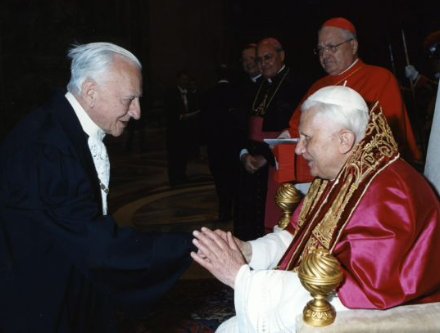
Search
Instagram: @andcusack
Click here for my Instagram photos.Most Recent Posts
- Bicycle Rack April 29, 2024
- Burns Tower April 19, 2024
- Patrick in Parliament March 18, 2024
- Articles of Note: 13 March 2024 March 13, 2024
- Cambridge March 9, 2024
Most Recent Comments
Book Wishlist
Monthly Archives
Categories


